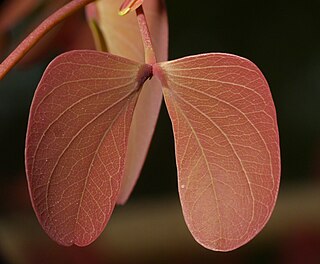
Pinus radiata, the Monterey pine, insignis pine or radiata pine, is a species of pine native to the Central Coast of California and Mexico. It is an evergreen conifer in the family Pinaceae.

Cupressus guadalupensis, the Guadalupe cypress, is a species of cypress from Guadalupe Island in the Pacific Ocean off western North America.

Drosera binata, commonly known as the forked sundew or fork-leaved sundew, is a large, perennial sundew native to Australia and New Zealand. The specific epithet is Latin for "having pairs" - a reference to the leaves, which are dichotomously divided or forked.
Beauprea congesta is a species of plant in the family Proteaceae. It is endemic to New Caledonia.
Beauprea crassifolia is a species of plant in the family Proteaceae. It is endemic to New Caledonia.
Helicia albiflora is a species of plant in the family Proteaceae. It is endemic to Papua New Guinea. It is threatened by habitat loss.
Helicia neglecta is a species of plant in the family Proteaceae. It is endemic to Papua New Guinea. It is threatened by habitat loss.
Heliciopsis whitmorei is a species of plant in the family Proteaceae. It is a tree endemic to Peninsular Malaysia. It is threatened by habitat loss.
Leucadendron nobile is a species of plant in the family Proteaceae. It is endemic to South Africa.
Paradrymonia binata is a species of plant in the family Gesneriaceae. It is endemic to Ecuador. Its natural habitat is subtropical or tropical moist montane forests.
Rytigynia is a genus of flowering plants in the family Rubiaceae. It is found in tropical and southern Africa. The genera Rytigynia and Fadogia form a strongly supported clade but neither of these genera is monophyletic.
Rytigynia caudatissima is a species of plant in the family Rubiaceae. It is endemic to Tanzania.
Rytigynia eickii is a species of plant in the family Rubiaceae. It is found in Kenya and Tanzania.
Vangueria induta is a species of flowering plant in the family Rubiaceae. It is found in Kenya and northern Tanzania.
Rytigynia longipedicellata is a species of plant in the family Rubiaceae. It is endemic to Tanzania. It is threatened by habitat loss.
Rytigynia nodulosa is a species of flowering plant in the family Rubiaceae. It is endemic to Tanzania.
Rytigynia pseudolongicaudata is a species of flowering plant in the family Rubiaceae. It is endemic to Tanzania.
Stenocarpus villosus is a species of plant in the family Proteaceae. It is endemic to New Caledonia. It is threatened by habitat loss.
Vangueria schliebenii is a species of flowering plant in the family Rubiaceae. It is endemic to Tanzania.

Hardwickia is a monotypic genus of flowering plant in the subfamily Detarioideae of the legumes. The only species is the anjan, Hardwickia binata, an Indian tree that grows some 25 to 30 m high. This plant genus was named after Thomas Hardwicke by William Roxburgh.
This page is based on this
Wikipedia article Text is available under the
CC BY-SA 4.0 license; additional terms may apply.
Images, videos and audio are available under their respective licenses.




